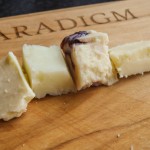Origin: Switzerland
We paid: 2.43e per 100g
Quick Description: A rubbery cheese often served melted.

First sniff: This one only smells a little bit like old fridge which, compared to some stinky blues, is quite an achievement! Izzy even declared the smell as ‘appetising’, so it’s off to a good start as it certainly smells like something we want to eat.
Strength: On a scale of one to the strength of the Incredible Hulk, we are putting this cheese on par with Neville Longbottom – although mild, it’s surprisingly powerful but only really useful in certain situations.
Taste: Although we don’t think this cheese is the most incredible we’ve tried, Gruyère’s distinctive taste has an interesting array of flavours. Although its flavour is unmistakeable, it can be easily overlooked as it’s not particularly pungent. So far we’re not blown away but then we’re not writing it off just yet. Both melted and raw this cheese has a largely earthy, nutty flavour. It has a slightly dry aftertaste that deactivates the control centre in our brains responsible for regulating our cheese intake (it didn’t take us long to polish the whole thing off). This is a quality we love in cheese and is very similar to the sensations aroused by Comté. According to our research Gruyère is t(ee)ypically enjoyed with Riesling (a German white wine). Or jam and bread.

GRUYERE
Texture: What do car tyres, trampolines, rubber ducks, bouncy balls, elastic bands* and Gruyère all have in common? Rubber! Mirroring Maria Von Trapp’s enthusiasm, this cheese is unfailingly resilient and doesn’t dissolve on your tongue like its creamier cousins. (See Figou). Gruyère has a springy texture that would put Zebedee to shame and almost comes away in pieces as you chew. So in an attempt to realise its full potential, and drawing upon our extensive knowledge of Swiss mountain cheeses, we decided to raise its core temperature. More common recipes dictate that Gruyere should be served as a fondue, however, lacking resources and having already consumed our entire supply of vin blanc, Ellen shoved that baby in a hot pan. We must have done something good! Although the rubbery texture was still two thirds of its personality, when it was heated our sample became much more pleasurable as it lost its pieceyness. The amount of oil that the cheese exuded was also quite remarkable.
Overall score: 4.5/10
Final thoughts: It’s a proper cheese; there are no frills or fancy additions and where it really shines is in cuisine. The flavour is there but for us, the texture is OTT even when it’s melted.
Until next time – So long farewell, auf wiedersehen, adieu, adieu, adieu, gru- yère and yère and yère.

GRUYERE
*When doing your own comparisons we strongly suggest you do not eat any of these listed items.
Disclaimer: Izzy may have been mistaken in thinking that the Sound of Music was set in Switzerland, inspiring the purchase of Gruyère for this post. It’s not, it’s set in Austria. Upon returning home she realised her fundamental error which rather undermined the theme of this post. We soldiered on nevertheless.



